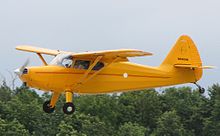
The Messerschmitt Bf 108 Taifun was a German single-engine sport and touring aircraft, developed by Bayerische Flugzeugwerke in the 1930s. The Bf 108 was of all-metal construction.
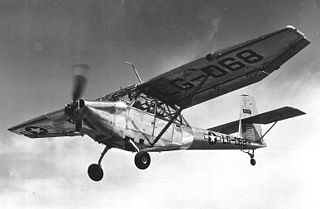
The Stinson L-13 was a US military utility aircraft first flown in 1945.
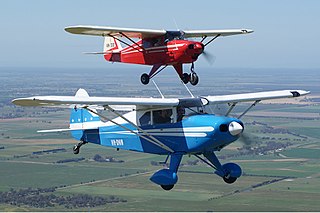
The PA-20 Pacer and PA-22 Tri-Pacer, Caribbean, and Colt are an American family of light strut-braced high-wing monoplane aircraft built by Piper Aircraft from 1949 to 1964.

The Piper PA-18 Super Cub is a two-seat, single-engine monoplane. Introduced in 1949 by Piper Aircraft, it was developed from the PA-11 Cub Special, and traces its lineage back through the J-3 Cub to the Taylor E-2 Cub of the 1930s. In close to 40 years of production, over 10,000 were built. Super Cubs are commonly found in roles such as bush flying, banner towing and glider towing.
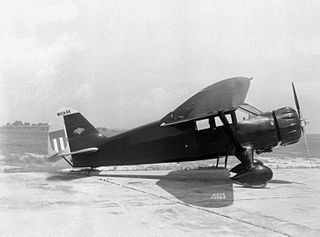
The Stinson Reliant is a popular single-engine four- to five-seat high-wing monoplane manufactured by the Stinson Aircraft Division of the Aviation Manufacturing Corporation of Wayne, Michigan.

The Aeronca 15AC Sedan is a four-seat, fixed conventional gear light airplane which was produced by Aeronca Aircraft between 1948 and 1951. Designed for personal use, the Sedan also found applications in utility roles including bush flying. The Sedan was the last design that Aeronca put into production and was the largest aircraft produced by the company.

The Aero-Flight Streak was an American two-seat light aircraft built in 1946 by Aero-Flight Aircraft Corporation at Buffalo, New York. Advanced for its time, it was of all-metal construction with tricycle undercarriage, and accommodated the pilot and passenger in tandem beneath a sliding, bubble canopy.
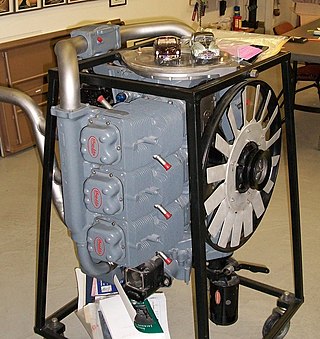
The Franklin O-335 was an American air-cooled aircraft engine of the 1940s. The engine was of six-cylinder, horizontally-opposed layout and displaced 335 cu in (5.5 L). The power output of later variants was 225 hp (168 kW).

The Stinson Voyager was an American light utility monoplane built during the 1940s by the Stinson Aircraft Company.
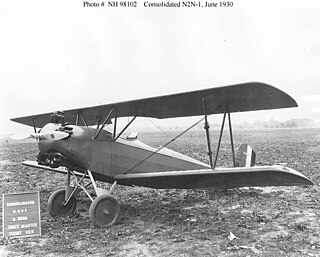
The Fleet Model 1 and its derivatives were a family of two-seat trainer and sports biplanes produced in the United States and Canada in the 1920s and 1930s. They all shared the same basic design and varied mainly in their powerplants.

The Goodyear GA-2 Duck was a 1940s American three-seat light amphibious aircraft built by the Goodyear Aircraft Corporation. The design team included David Thurston, who later developed several other light seaplanes including the Colonial Skimmer, Lake Buccaneer, Thurston Teal and Seafire. Only 19 aircraft were built, and these were used only for testing and as demonstrators.
The Piper PA-6 Sky Sedan was a 1940s American four-seat light aircraft designed and built in prototype form by Piper Aircraft at its Lock Haven, Pennsylvania, factory.

The Stinson SM-6000 Airliner was a 1930s three-engined (trimotor) ten-passenger airliner designed and built by the Stinson Aircraft Corporation. The SM-6000 was a high-wing braced monoplane with room for a pilot and a cabin for ten passengers. It was powered by three 215 hp (160 kW) Lycoming R-680 engines strut-mounted one each side above the main landing gear units and one in the nose. A number of variants were built mainly with improved interiors. In 1932 the Model U Airliner was produced which had low-set stub wings with an engine mounted at each wingtip.
The Dätwyler 1038 MDC Trailer was a 1960s Swiss glider tug variant of the American Piper PA-18 Super Cub.

The Stits SA-3A Playboy is a single seat, strut-braced low-wing monoplane that was designed by Ray Stits for amateur construction. The aircraft was designed and the prototype was completed in a three-month period during 1952. The design went on to become one of the most influential in the post-war boom in aircraft homebuilding.

The Convair Model 118 ConvAirCar was a prototype flying car of which two were built. Intended for mainstream consumers, two prototypes were built and flown. The first prototype was lost in an accident due to fuel exhaustion. Subsequently, the second prototype was rebuilt from the damaged aircraft and flown. By that time, little enthusiasm remained for the project and the program ended shortly thereafter.

The Stinson Model O was an American single-engined military trainer aircraft of the 1930s designed built by the Stinson Aircraft Company. Based on the Stinson SR, the Model O was designed to meet a requirement of the Honduran Air Force, forming the initial equipment of that air arm.
The 'Sznycer SG-VI' was a single-engined three-seat utility helicopter designed and built in the United States and Canada in the late 1940s to the design of Bernard Sznycer, assisted by Selma Gottlieb and Engineering Products of Canada Ltd. (CanAmerican)
The Leins Bal-Aire was a US sports biplane designed and built by a professional pilot for his own use, completed in 1960.

The Stinson Model R was an American light aircraft built by the Stinson Aircraft Company in the early 1930s. It was a single-engine high-winged monoplane, developed from the Stinson Junior. 39 units were built.



